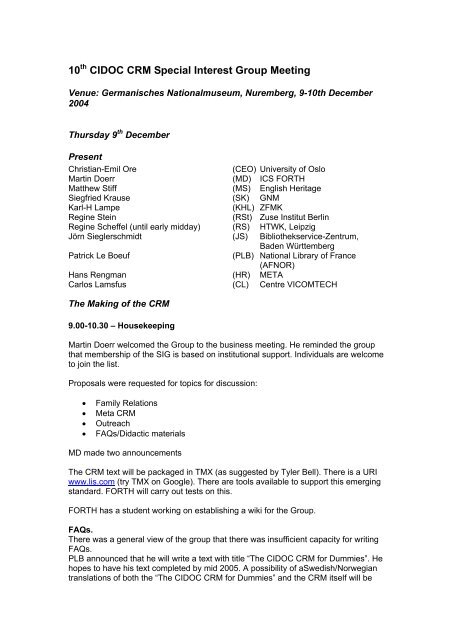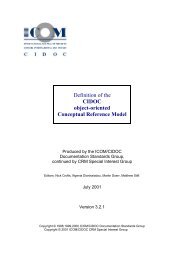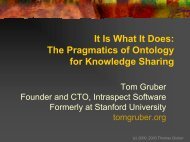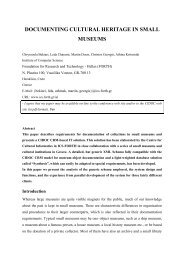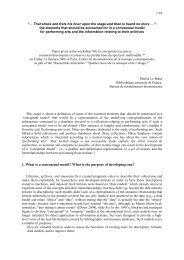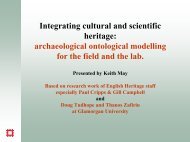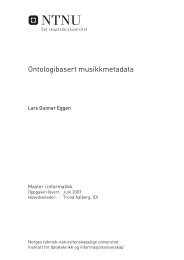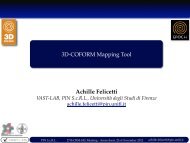10th CIDOC CRM Special Interest Group Meeting - The CIDOC CRM
10th CIDOC CRM Special Interest Group Meeting - The CIDOC CRM
10th CIDOC CRM Special Interest Group Meeting - The CIDOC CRM
You also want an ePaper? Increase the reach of your titles
YUMPU automatically turns print PDFs into web optimized ePapers that Google loves.
10 th <strong>CIDOC</strong> <strong>CRM</strong> <strong>Special</strong> <strong>Interest</strong> <strong>Group</strong> <strong>Meeting</strong><br />
Venue: Germanisches Nationalmuseum, Nuremberg, 9-<strong>10th</strong> December<br />
2004<br />
Thursday 9 th December<br />
Present<br />
Christian-Emil Ore (CEO) University of Oslo<br />
Martin Doerr (MD) ICS FORTH<br />
Matthew Stiff (MS) English Heritage<br />
Siegfried Krause (SK) GNM<br />
Karl-H Lampe (KHL) ZFMK<br />
Regine Stein (RSt) Zuse Institut Berlin<br />
Regine Scheffel (until early midday) (RS) HTWK, Leipzig<br />
Jörn Sieglerschmidt (JS) Bibliothekservice-Zentrum,<br />
Baden Württemberg<br />
Patrick Le Boeuf (PLB) National Library of France<br />
(AFNOR)<br />
Hans Rengman (HR) META<br />
Carlos Lamsfus (CL) Centre VICOMTECH<br />
<strong>The</strong> Making of the <strong>CRM</strong><br />
9.00-10.30 – Housekeeping<br />
Martin Doerr welcomed the <strong>Group</strong> to the business meeting. He reminded the group<br />
that membership of the SIG is based on institutional support. Individuals are welcome<br />
to join the list.<br />
Proposals were requested for topics for discussion:<br />
• Family Relations<br />
• Meta <strong>CRM</strong><br />
• Outreach<br />
• FAQs/Didactic materials<br />
MD made two announcements<br />
<strong>The</strong> <strong>CRM</strong> text will be packaged in TMX (as suggested by Tyler Bell). <strong>The</strong>re is a URI<br />
www.lis.com (try TMX on Google). <strong>The</strong>re are tools available to support this emerging<br />
standard. FORTH will carry out tests on this.<br />
FORTH has a student working on establishing a wiki for the <strong>Group</strong>.<br />
FAQs.<br />
<strong>The</strong>re was a general view of the group that there was insufficient capacity for writing<br />
FAQs.<br />
PLB announced that he will write a text with title “<strong>The</strong> <strong>CIDOC</strong> <strong>CRM</strong> for Dummies”. He<br />
hopes to have his text completed by mid 2005. A possibility of aSwedish/Norwegian<br />
translations of both the “<strong>The</strong> <strong>CIDOC</strong> <strong>CRM</strong> for Dummies” and the <strong>CRM</strong> itself will be
investigated. MD stressed the importance of having the services of a professional<br />
translator who is sufficiently instructed about the meanings in the <strong>CRM</strong>.<br />
MS to make available high-level information material for decision makers by January<br />
2004. He is producing this for internal use at EH.<br />
<strong>The</strong>re are currently SIS-TELOS and RDFS encodings of the <strong>CRM</strong> (4.0) available on<br />
the <strong>CRM</strong> website. An evaluation licence of the SIS database and visualization tool is<br />
available for free.<br />
FORTH is also working on an automatic 3-dimensional layout algorithm for partial<br />
views of the <strong>CRM</strong>. Possibly a Protégé plug-in could be produced, funds permitting.<br />
MD announced that he had been approached by two people (from Springer and<br />
Kluwer) suggesting the production of a monograph on the <strong>CRM</strong>. 300-400 pages<br />
would seem appropriate. This will include the text of the <strong>CRM</strong> (copyright issues<br />
would need to be resolved on this). It is hoped that these problems could be<br />
resolved. Envisaged structure:<br />
• An introduction<br />
• A computer-science-oriented description of the <strong>CRM</strong>,<br />
• parts from PLB’s text,<br />
• discussions of successful applications or details of <strong>CRM</strong> functional units (a<br />
<strong>CRM</strong> cookbook)<br />
• <strong>The</strong> definition of the <strong>CRM</strong>.<br />
PLB, MS, SK and CL to work on this.<br />
Dissemination<br />
MS reported back on his presentation to the Dutch Digital Heritage Association<br />
conference in Arnhem. He suggested follow-up contact with those involved in the<br />
Dutch Heritage portal project, to be arranged in the New Year.<br />
JS suggested further contacts with the library and archive communities, through<br />
conferences etc.<br />
KHL suggested further mappings of domain-specific events, possibly through<br />
dedicated meetings. This would demonstrate the potential of the <strong>CRM</strong> for horizontal<br />
rather than vertical information transfer. This could be done under the umbrella of<br />
<strong>CIDOC</strong>. MD pointed out that this is on the same lines of the work with the Centre for<br />
Archaeology in the UK. He suggested that we could collect examples of domainspecific<br />
extensions or better specializations of the <strong>CIDOC</strong> <strong>CRM</strong>. KHL suggested that<br />
these domain-specific specializations could be brought together and published as a<br />
book. JS mentioned GBIF. MD discussed the importance of contacts with the archival<br />
community (e.g. the editors of EAD). RS mentioned that in Germany there is a<br />
different tradition in describing archival material. SK said that this is now changing<br />
and that EAD is now beginning to be used even in Germany.<br />
CEO reported back on discussions on the TEI list on establishing a list for the<br />
discussion of ontologies. This was accepted by TEI, and there was further discussion<br />
at the TEI annual meeting in Baltimore. He also discussed the Master Project. MD<br />
felt that it would be worthwhile if more than one person could follow up on such<br />
application-specific issues. MS suggested engaging Richard Light. MS also agreed to<br />
engage in this work. Dolores will also be interested (and MD will do what he can!).<br />
KHL will be interested in biological applications.
HR mentioned the museum week in Gothenberg/Stockholm (late March). He<br />
suggested some kind of museum/library/archive-linking workshop.<br />
www.BAM-Portal.de<br />
MS discussed the problems of DC-Culture and its prevalence. It was felt that there<br />
could be a better, <strong>CRM</strong>-based proposal than DC-Culture with equal simplicity. MS<br />
and MD agreed to work together on approaches to dealing with DC-Culture and<br />
proposing alternatives.<br />
Meta-<strong>CRM</strong><br />
Following the workshop presentation of the “Meta-<strong>CRM</strong>” proposal by MD the day<br />
before, RG felt that although the discussion was interesting it was too early to pursue<br />
this. HR was concerned about using the <strong>CRM</strong> in this way. Introducing fuzzy notions<br />
such as “usually” may weaken the intellectual rigour of the <strong>CRM</strong>. MD pointed out that<br />
the Meta-<strong>CRM</strong> is only a logical interpretation and hence application of the <strong>CRM</strong> – it<br />
does not alter the semantics of the model. HJH asked for further examples to clarify<br />
the proposal. MD pointed out that it was the first study that FORTH had made of this.<br />
He was anxious to avoid the confusion feared by RS. He stated that he proposed it<br />
as an application of the <strong>CRM</strong>. MD also mentioned the criticism of the <strong>CRM</strong> that it<br />
uses the <strong>CRM</strong> typing mechanism as a “rubbish bin”. He talked about work<br />
undertaken to create type hierarchies parallel to the <strong>CRM</strong> (types of types). <strong>The</strong>se will<br />
be labeled with ‘T’ numbers following older decisions of the <strong>Group</strong>. MS expressed<br />
interest in this approach.<br />
PLB thought that the Meta-<strong>CRM</strong> would be useful in solving FRBR-<strong>CRM</strong> issues. RSt<br />
was interested but raised the question of what is ‘usual’. GG asked for more<br />
examples of the usage of this Meta-<strong>CRM</strong>, particularly in dealing with exceptions. <strong>The</strong><br />
need for standard expections. CEO pointed out that the Meta-<strong>CRM</strong> can be used to<br />
model instances of theories. MD asked GG if he had experience of such reasoning<br />
systems. GG confirmed that he did and elaborated some examples.<br />
MD talked about the problem in modelling discussions of to distinguish between a<br />
class of like items or a collection of particular item – two viewpoints that are modeled<br />
completely differently but may not easily be distinguished in practice. MD stated that<br />
we need people with particular examples for the Meta-<strong>CRM</strong> in order to decide its<br />
utility and optimal form. KHL, CEO and GG all expressed interest. JS expressed his<br />
continuing concern about this modeling. He was worried about properties that might<br />
not be rigidly defined. MD emphasized that he was not making any proposal about<br />
the standard, only about a practical application derived from the standard. He also<br />
reminded the group that the <strong>CRM</strong> is full of properties that have cardinality (0,n),<br />
which means they describe particular things have particular possibilities rather than<br />
fixed properties.<br />
<strong>The</strong> group endorsed the Meta-<strong>CRM</strong> application as a useful approach.<br />
<strong>The</strong> group broke for coffee at 10:35.<br />
Family Relations<br />
<strong>The</strong> <strong>CRM</strong> currently describes family relations by Birth events and assumed<br />
fatherhood. This is a maximal elementary analysis for genetically determined family<br />
relations except for loan-mothers and cloning. <strong>The</strong>re are problems in describing<br />
family relations where the genetic intermediates (common ancestors) are not known.
<strong>The</strong>re are also legal and social relations that have a status of family relations to be<br />
described.<br />
CEO outlined some of the issues. E67 Birth has properties for the Mother (P96), the<br />
assumed father (P97) and the child (P98). This is has some problems with it. For<br />
example, it doesn’t allow for adoption. CEO wondered about the use of the<br />
Acquisiton event. MD considered that this was not appropriate. CEO agreed, but a<br />
similar event is required to deal with the legal aspects of adoption:<br />
A legal relationship is established by an activity.<br />
A genetic relationship is established by birth (except for loan-mothers)<br />
A social relationship is established by “bringing up” someone.<br />
MD suggested creating an adoption event. He warned against modeling events for<br />
which we have no evidence in databases.<br />
MD proposed:<br />
Actor<br />
E21 Person<br />
Adoption<br />
carried out by<br />
Father/Mother of<br />
(Child of)<br />
Family<br />
relationship (has<br />
type)<br />
Adopted<br />
E21 Person<br />
<strong>The</strong> importance of parenthood as a legal construct was discussed. Different cultures<br />
approach this issue differently. MD expressed the importance of the Adoption event<br />
in establishing the relationship. This is different to characterizing a longer-lasting<br />
social activity that establishes a de-facto bond.<br />
MD asked how the deassignment of adoption should be modeled (in order to<br />
preserve the symmetry of the model). CEO stated that adoption should be modeled<br />
in the same way as Transfer of Custody/Acquisition.<br />
MD talked about other relationships with open numbers of intermediates – e.g.<br />
uncles, aunts, cousins etc.<br />
Proposal: <strong>The</strong>re should be a <strong>CRM</strong> extension dealing with family relationships. JS<br />
suggested that this should be done by someone with ethnological knowledge to<br />
ensure that we do not impose a Western construct to family relationships.
Action: CEO to discuss these issues with anthropologists. <strong>The</strong>se relationships to be<br />
discussed in terms of the activities that lie behind them. MS and CEO to collaborate<br />
in formulating requirements for the expression of relationships between people.<br />
Corrections to <strong>CRM</strong> Text.<br />
<strong>The</strong> group then undertook obvious corrections to the <strong>CRM</strong> text that were proposed<br />
by groups translating the <strong>CRM</strong>. <strong>The</strong> version used was the current official release<br />
(4.0).<br />
PLB focused on problems remaining.<br />
MD stated that the word Event was used to add clarity. MS said that, if this<br />
clarification is to be retained, then the word Activity should be used. <strong>The</strong>re was no<br />
consensus if this should be proposed as change to the standard.<br />
Decision/Action: Change to ‘Activity’ to be raised as formal Issue for later decision<br />
by the group.<br />
Issue: <strong>The</strong> suggestion to change ‘Stuff’ to ‘Thing’. MD was opposed to introducing<br />
terminological discussion. He felt that this should not be opened up if there was not<br />
an urgent need to do so. He expressed the view that the term ‘Stuff’ has already its<br />
own history. <strong>The</strong>se should be gathered for the next edition with input from a wider<br />
group. RSt felt that we should avoid changing terms if at all possible as it is being<br />
used already. MD raised the issues of translation – <strong>The</strong> concept is defined by the<br />
scope note, not the term. We seek a term in language best suited to the concept<br />
rather than attempting to translate the English term where no direct equivalent exists.<br />
Decision: To be noted as Issue for resolution in a later edition of the <strong>CRM</strong><br />
Pending Issue: E28 <strong>The</strong> definition of Conceptual Object is too narrow. A photo is not<br />
a product of our mind, but it can be analyzed by our mind. <strong>The</strong> very nature of the<br />
photo seems to reside in its signal or sensory nature. To be refined.<br />
Decision: Post as issue to list for discussion and later decision.<br />
Issue: Paragraph, Naming Conventions: 4 th bullet point: ‘P2 has note’ should read<br />
‘P3 has note’.<br />
Decision: Accepted<br />
Issue: Paragraph, About Types: “This enables the specific instance of the casting to<br />
be associated with the entire class of manufacturing devices known as moulds …”<br />
replace with “This enables the specific instance of the casting to be associated with<br />
the entire type of manufacturing devices known as moulds …”<br />
Decision: Accepted<br />
Issue: <strong>The</strong> diagrams in the introductory text have been transposed.<br />
Decision: Accepted<br />
Issue: E8 Acquisition Event<br />
Replace: ‘any other instances of E30 Right’ with<br />
’any other types of E30 Right’. Discussion ensued. Suggested rewording ‘any other<br />
kinds of right’. This gets over ambiguities in E30.<br />
Decision: Accepted.<br />
Issue: E8 Acquisition Event
Replace: ‘require the donor and/or recipient to be included’ with ‘<strong>The</strong> recording of the<br />
donor and/or recipient is optional. It is possible that in an instance of E8 Acquisition<br />
Event there is either no donor or no recipient.’<br />
Decision: Accepted<br />
Issue: E8 Acquisition Event<br />
3 rd example “the loss of my stuffed ‘Fringilla coelebs …” should read “the loss of my<br />
stuffed chaffinch ‘Fringilla coelebs …”<br />
Issue: E10 Transfer of Custody<br />
See above. See amended text for new version (as above).<br />
Add ‘<strong>The</strong> receipt of custody from an unknown source’.<br />
Decision: Accepted<br />
Issue: E28 Conceptual Object.<br />
Replace ‘Instances of E28 Conceptual Object need not have a particular carrier’, with<br />
‘Instances of E28 Conceptual Object may be found on more than one particular<br />
carrier’.<br />
Decision: Accepted<br />
Issue: E36 Visual Item.<br />
Replace: ‘This class does not intend to describe the idiosyncratic characteristics of<br />
an individual physical embodiment of an inscription, but the underlying prototype’ with<br />
‘This class does not intend to describe the idiosyncratic characteristics of an<br />
individual physical embodiment of a visual item, but the underlying prototype.<br />
(Obviously a "cut and paste" effect from E34)<br />
Decision: Accepted<br />
Issue: E41 Appellation<br />
<strong>The</strong> phrase: ‘Because of this, there are no properties linking to values of E41<br />
Appellation’ is obsolete.<br />
Decision: Accepted<br />
Issue: E41 Appellation<br />
Replace: ‘Specific subclasses of E41 Appellation should be used when instances of<br />
E41 Appellation of a characteristic form are used for particular objects’ with ‘Specific<br />
subclasses of E41 Appellation should be used when instances of E41 Appellation of<br />
a characteristic form are used for particular kinds of items’.<br />
Decision: Accepted<br />
Issue: E44 Place Appellation<br />
Scope note for E44 Place Appellation: A the beginning of the 3 rd line it should read<br />
‘the same instance of E44 Place Appellation.<br />
Decision: Accepted<br />
Issue: E45 Address<br />
E48 Place Appellation should read E44 Place Appellation<br />
Decision: Accepted<br />
Issue: E45 Address<br />
This class comprises mainly postal addresses used for mailing.”….and what else?<br />
Replace with ‘This class comprises identifiers expressed in coding systems for<br />
places, such as postal addresses used for mailing’<br />
Decision: Accepted
Issue: E55 Type<br />
<strong>The</strong> last paragraph of Scope note:<br />
E56 Language, E57 Material and E58 Measurement Unit have been defined explicitly<br />
as elements of the E55 Type hierarchy because they do not correspond to an explicit<br />
class in the Model, e.g., the property instance “ consists of : gold” does not refer to a<br />
particular instance of gold.<br />
Replace with<br />
E56 Language, E57 Material and E58 Measurement Unit have been defined explicitly<br />
as elements of the E55 Type hierarchy because they are used categorically in the<br />
model without reference to instances of them, i.e. the Model does not foresee the<br />
description of instances of instances of them, e.g., the property instance “P45<br />
consists of : gold” does not refer to a particular instance of gold.<br />
Issue: E56 Language<br />
Replace “This class is a specialization of E55 Type and comprises the names<br />
identifying natural languages” with “This class is a specialization of E55 Type and<br />
comprises the types of measurement units: feet, inches, centimetres, litres, lumens,<br />
etc.”<br />
Issue: E56 Language<br />
Replace “This type does not correspond to an explicit class in the Model” with “It is<br />
used categorically in the model without reference to instances of it, i.e. the model<br />
does not forsee the description of instances of instances of E56 Language, e.g.:<br />
“instances of Mandarin Chinese”.<br />
Issue: E56 Language<br />
Replace” ISO codes, such as those defined in ISO 639:1988, should be used as<br />
instances of E56 Language, if the respective language is defined” with “It is<br />
recommended that internationally or nationally agreed codes and terminology are<br />
used to denote instances of E56 Language, such as those defined in ISO 639:1988.”<br />
(this paragraph moved at the end of Scope note)<br />
Decision: Accepted<br />
Issue: E57 Material<br />
Replace “This class is a specialization of E55 Type and comprises the names used<br />
to identify materials.” with This class is a specialization of E55 Type and comprises<br />
the concepts of materials.<br />
Decision: Accepted<br />
Issue: E57 Material<br />
Replace “This type does not correspond to an explicit class in the Model” with “It is<br />
used categorically in the model without reference to instances of it, i.e. the model<br />
does not forsee the description of instances of instances of E57 Material, e.g.:<br />
“instances of gold”.<br />
Decision: Accepted<br />
Issue: E57 Material<br />
Order of phrases: International codes… Move this phrase to end of scope note as<br />
separate paragraph. Rephrase as ‘It is recommended that internationally or nationally<br />
agreed codes and terminolgy are used.<br />
Decision: Accepted<br />
Issue: E58 Measurement Unit
Replace “This class is a specialization of E55 Type and comprises terms for all types<br />
of measurement units: feet, inches, centimetres, litres, lumens, etc..” with “This class<br />
is a specialization of E55 Type and comprises the types of measurement units: feet,<br />
inches, centimetres, litres, lumens, etc..”<br />
Decision: Accepted<br />
Issue:E58 Measurement Unit<br />
Replace “This type does not correspond to an explicit class in the Model” with “It is<br />
used categorically in the model without reference to instances of it, i.e. the model<br />
does not forsee the description of instances of instances of E58 Measurement Unit,<br />
e.g.: “instances of cm”.<br />
Decision: Accepted<br />
Issue: E58 Measurement Unit<br />
<strong>The</strong> paragraph” Système International (SI) units or internationally …” moved at the<br />
end of Scope note.<br />
Decision: Accepted<br />
Issue: E63 Beginning of Existence and E64 End of Existence<br />
PLB raised the use of the term termini postquem and antequem. <strong>The</strong>se are<br />
grammatically incorrect. <strong>The</strong>se should be written terminus postquem and terminus<br />
antequem (singular form) or termini postquos and antequos (plural form).<br />
Decision: Accepted<br />
Issue: E65 Creation Event<br />
In the Scope note replace: “classes “ with “types”<br />
Issue: E69 Death<br />
Subclass of: “E63 End of Existance” should read “E64 End of Existance”<br />
Decision: Accepted<br />
Action: Check all E numbers!<br />
Issue: E69 Deth<br />
“If the E21 Person was killed, the E69 Death event should also be instantiated as an<br />
E7 Activity. <strong>The</strong> E69 Death or perishing of other living beings should be documented<br />
using E64 End of Existence. “<br />
: rubbish insertion of E numbers… Replace with: ‘If a person is killed, their death<br />
should be instatiated as E69 Death and as E7 Activity. <strong>The</strong> death or perishing of<br />
other living beings should be documented using E64 End of Existence.<br />
Decision: Accepted<br />
Issue: E83 Type Creation<br />
In the Scope note replace: “classes “ with “types”<br />
Issue: P20 had specific purpose (was purpose of)<br />
bad syntax first phrase. “This property describes the relationship between an E7<br />
Activity and an activity that it is intended as a preparation for”. Replace with “This<br />
property describes the relationship between a preparatory activity and the activity it is<br />
intended for”.<br />
bad example. Use archaeological example (Knossos workshop?). See amended text<br />
Decision: Accepted.<br />
Issue: P21 had general purpose (was purpose of): “type” not “class of Activity,<br />
Decision: Accepted
Issue: P21 Examples – Replace example with archaeological example. e.g. halffinished<br />
statue from Easter Island.<br />
Action: SK to find archaeological example.<br />
Issue: P25 moved (moved by).<br />
Date of Exhibition should be 1874<br />
Decision: Accepted<br />
Issue: P25 moved (moved by).<br />
<strong>The</strong> example ““Impression sunrise” (E22) …” should read “Monet´s “Impression<br />
sunrise” (E22) …”<br />
Decision: Accepted<br />
Issue: P27 moved from (was origin of) – Example should read <strong>The</strong> Egyptian<br />
Museum<br />
Decision: Accepted<br />
Issue: P34 concerned (was assessed by)<br />
At 2 nd line of Scope note should read “Stuff does NOT need…”<br />
Decision: Accepted.<br />
Issue: P34 concerned (was assessed by)<br />
should read E14 Condition Assessment not E14 Conditional Assessment<br />
Decision: Accepted<br />
Issue: P35 has identified (identified by)<br />
as above.<br />
Decision: Accepted<br />
Issue: P39/40 E-numbers are missing, E number inserted into edited text. See<br />
amended text.<br />
Decision: Accepted<br />
Issue: P48/50/52/54/55: “was instantiated” replace with “was recorded”.<br />
Decision: Accepted<br />
Issue: P65 shows visual item (is shown by)<br />
<strong>The</strong> example should read Impression_Sunrise.jpg (E38).<br />
Decision: Accepted<br />
Issue: P102 has title (is title of)–<br />
2 nd line of Scope note. Change P02 to P102.<br />
Decision: Accepted<br />
Issue: Ref. to Allen missing.<br />
Competed in P114/115/116/117/118/119/120<br />
Issue: P128 carries (is carried by)<br />
this property is a super-property of P65 is missing.<br />
Decision: Accepted<br />
Issue: P129 is about (is subject of)<br />
Typo – E73 Informationl should be E73 Information.<br />
Decision: Accepted
Issue: P135 created type (was created by) –<br />
Change example to read “<strong>The</strong> description of a new ribbon worm species by Würger<br />
(E83) created type ‘Lineus coxinus (Bürger, 1892)’(E55)<br />
Decision: Accepted<br />
Issue: P136 was based on (supported type creation)<br />
Change example to read “the taxon creation of the plant species ‘Serratula glauca<br />
Linné, 1753.’ (E83) was based on Object BM000576251 of the Clayton Herbarium<br />
(E20) in the taxonomic role original element (E55)”<br />
Decision: Accepted<br />
Issue: P140 assigned attribute to (was attributed by)<br />
Second example should read ‘assigned attribute to’ not ‘registered’.<br />
Decision: Accepted<br />
Issue: P141 assigned (was assigned by)<br />
Typo – remove full stop after E16<br />
Decision: Accepted<br />
Translation Guidelines<br />
Amendments were made to the translation guidleines. See amended text. <strong>The</strong><br />
guidelines are hereby accepted by the <strong>Group</strong>.<br />
<strong>The</strong> group finished work at 17:10.<br />
Friday 10 th December 2004<br />
<strong>The</strong> group was joined by<br />
Dolores Iorizzo (DI) Newton Project, Imperial College<br />
Dirk Witthart (DW) AdLib Information Systems<br />
Georg Hohmann (GH) Köln Univeristät<br />
Axel Ermert (AE) Berlin<br />
Housekeeping (continued)<br />
Outstanding Action: MD to make proposal to <strong>CRM</strong> SIG on how to format examples<br />
for translation purposes.<br />
Outstanding Action: MS to produce list of FAQs by Mid January 2005.<br />
Outstanding Action: Mapping repository to part of wiki tiki<br />
Outstanding Action: FRB/<strong>CRM</strong> Harmonisation – Document needs refinement to be<br />
carried out at next <strong>CRM</strong>/FRBR meeting.<br />
Outstanding Action: Graphical representation – MD and SDS have produced a text<br />
for <strong>CIDOC</strong> categories. This could be a good starting point (it also contains a list of<br />
FAQs. MD to send copy to MS. MS and PLB to work on text to go with illustrations.<br />
Outstanding Action: Tutorial – Still in progress<br />
Outstanding Actions:
MD emphasised that <strong>CRM</strong> encoding is a political issue. RDFS or OWL encoding<br />
should be seen as interpretations of the <strong>CRM</strong>, not recommendations. DI suggested<br />
that the <strong>CRM</strong> SIG should publish a note on this issue.<br />
Action: MD to write short note covering <strong>CRM</strong> encodings. This should cover their<br />
respective limitations.<br />
Action: RL’s mapping tool. MS reported that work on this is on hold – Will report<br />
back in March 2005.<br />
Action: MS to send Allen operator paper to MD by Christmas 2004.<br />
Action: MS to discuss teaching the <strong>CRM</strong> with Tyler Bell.<br />
Action: Checking of Diagrams. RSt agreed to work on this.<br />
MD outlined work undertaken covering thesaurus proposals and treatements of<br />
events and time. Papers delivered to CAA – To be placed on <strong>CRM</strong> SIG website.<br />
<strong>The</strong> Future of the <strong>CRM</strong> – CHIOS 2<br />
MD outlined the range of possibilities. He emphasised that a larger project would<br />
have more limited chance of success. He stated that a proposal has been<br />
encouraged for the 6 th Framework 5 th call (September 2005).<br />
DI reported back on presentations on EC funding. 300-500,000 euros would be a<br />
good range to pitch for over a 3 year period. MD suggested that we should not ask<br />
for more than 300,000 euros. DI suggested finding ways of including Daniel Pitti. This<br />
should be possible with the inclusion of a budget for travel.<br />
A discussion ensued on prioritisation of themes for CHIOS 2<br />
1. Dissemination<br />
a. Training<br />
b. <strong>CRM</strong> Monograph<br />
To make the <strong>CRM</strong> available and accessible to a wide range of<br />
communities – Showing how it relates to other people’s data structures.<br />
Rich impact<br />
Map texts<br />
In to science<br />
Historic view on experiments<br />
Bringing together overlapping info<br />
2. Extensions<br />
a. Dialogue<br />
b. Enforcing coherence of interpretation<br />
c. “Approval”<br />
DI talked about need for a more formalised structure for the further development of<br />
the <strong>CRM</strong>.
3. Community building<br />
a. National Centres of Excellence<br />
Decisions:<br />
Meta <strong>CRM</strong> cannot be funded as work as part of a support action. More research work<br />
is required for this.<br />
A requirement exists to extend influence to the Unites States. TEI, EAD, RLG<br />
communities required. DI stated that Imperial College is a member of RLG.<br />
Overall objective:<br />
Foundations for interoperating - Archives, Libraries, Museums →<br />
Science/Humanities repositories<br />
Measures for CHIOS 2 Proposal<br />
1. Organisation of Centres of Excellence, dialogue with interest groups – MS, TB &<br />
DI.<br />
2. *Harmonsiation work (FRBR, TEI etc.) – DI, PLB<br />
3. Approval service<br />
Domain specialisations – SK, KHL<br />
Extensions<br />
4. Coordinating formalisations – CL & MD<br />
“Ontological commitment”<br />
5. Didactic material - PLB<br />
*Formulate a model for the <strong>CRM</strong> Lifecycle – a paper to use to initiate political<br />
bargaining. (an alternative to the Semantic Web)<br />
Action: DI, KHL, SK and MS agreed to assist in formulating proposal. Other to assist<br />
as outlined above. MD to compose introductory text. MS to provide editorial support.<br />
Timetable:<br />
Information is available on CORDIS 6 th Framework IST Programme – Latest update<br />
of the work programme and underline all political statements. Each country has an<br />
IST contact point.<br />
Announcements are made for calls. <strong>The</strong>se include lists of topics – Check those on<br />
the list for the 5 th call. Download the template – Guide for proposers. Look only at the<br />
technical descriptions (the first parts). Needs to show how this fits in with European<br />
policies and initiatives.<br />
Action: All to check URL on CORDIS website and submit URL to <strong>CRM</strong> SIG list to<br />
confirm correct documentation.<br />
Action: First thoughts to be submitted by mid-late January (initial draft).<br />
Action: Mid February first draft to be produced in template format.<br />
Action: 11 th <strong>CIDOC</strong> <strong>CRM</strong> <strong>Meeting</strong> – Crete. June/July 2005. Programme should<br />
relate to DI, SK, CEO and MD to act as Programme Committee.<br />
Action: <strong>CRM</strong>/FRBR meeting to be held at Imperial College, London, February 2005.<br />
Announcement to be made to list ASAP.
Further discussion to be held on list.<br />
<strong>The</strong> Workshop closed at 12:30. <strong>The</strong> group thanked SK for his organisation.


